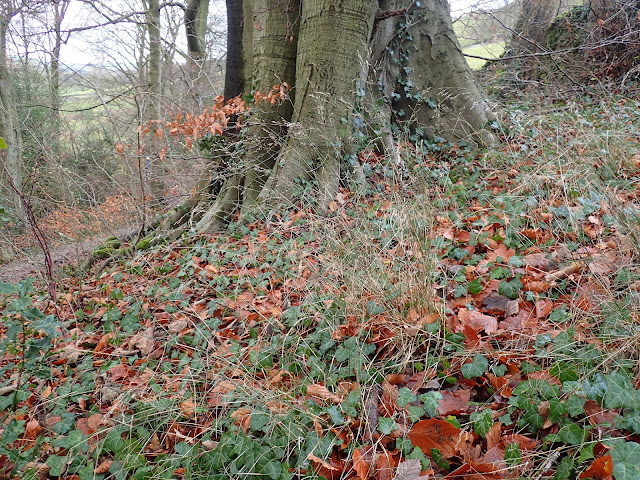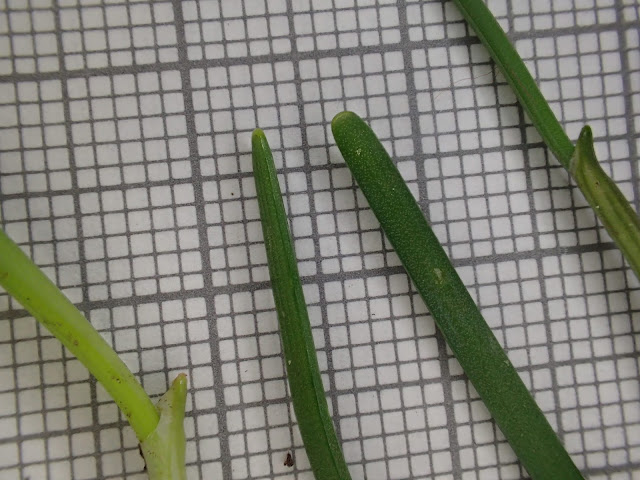We have very few orange wildflowers in this country; Most insects cannot see the colour orange. So only flowers of other colours are successfully pollinated.
Here at last, at the foot of Castleberg Crag, I have another orange flower - Wallflower. Erysimum cheiri. Like most of the other orange flowered plants, is a garden escape. Wallflowers come out in early spring. and on several New Year Plant Hunts I find one.
It is December 1st - the first of the month
 |
| The Wallflowers are at the foot of the cliff to the right of the picture. |
 |
I make two visits to Castleberg Crag - one on 1st December; then one on 6 December
1. 1st December:
Churches Together in Settle have started doing a "Walk for the climate on the first day of the month" and Castleberg Crag- Settle's "Town Park" is a good place to go for a walk
There are lots of Wallflower plants at foot of the climbing cliff near the top of Castleberg but I only found one in flower. (I found more on 6th)
I am keen to continue with the tradition (started last month) of going for a walk with Churches Together to take part in the national "Pray and Fast for the Climate" scheme. In Settle we do "Walk for the climate - Litter Picking and Observing Nature and Flowers en route". This time due to Covid Restrictions not allowing groups of bigger than 2, it is myself and Rev Stephen Dawson. Tuesday morning has an excellent sunny foreecast.
A drawing of the hill from the 1700s shows Castleberg as a grassy (rocky?) but definitely treeless slope, with slabs laid out on the way up to act as a Sundial.
In. c. 2000 I joined a group from Craven Conservation Group and the Yorkshire Dales Conservation Volunteers led by Russ Turner. We cut down a lot of the young trees and scrub on the slope to let light reach the ground flora. "Don't get sad about cutting the trees and saplings," Russ said. "It will coppice and there will be more trunks than ever."
Quite true. The trees are getting denser. There is not much ground vegetation except periwinkle, and near the entrance Field Garlic. Allium oleraceum ssp oleraceum (see picture at end)
In 2008 Churches Together held our traditional "Dawn" or early morning Service on Easter Sunday. It snowed. The all-aged participants - some very elderly - made it up the slope to the flat area near the bottom. That was the last year we held it here. Since then it has been held adjacent to one of the town car parks.
I list the other flowers seen : Smooth Sow-thistle, Golden Oatgrass, Leafy Hawkweed, Wall Lettuce, and Herb Robert - but I'm saving Herb Robert for another day.
Just below the crag a lot of scrub has been cut down - well done - good to open up and area.
At the summit the sloe bushes which formed a protective thick spiky hedge between the path at the top and the vertical twenty foot plus drop have been removed.
I am concerned about that.
It would be easy for someone to step backwards and fall the 20 foot plus drop.
Worse, someone might say "it is not safe" and then prevent people going up.
The noise of a drill down at roadworks in the street below somewhat disturbs the silence.
From the top we can with the now revealed much better panoramic view see far and wide - including just to the top of Giggleswick Church, almost hidden in the valley behind Settle College (High School) .
I look at the "Wildlife in a churchyard book" that my friend Doris Cairns has at last produced about Giggleswick churchyard
 |
| View of top of Giggleswick Church Tower from the the top of Castleberg - It is just behind Settle College in the foreground. |
 |
| There is a Leafy Hawkweed in flower near the flagpole |
We continue litter picking - it is difficult on the steep slope.
2. On Sunday 6 December I return,
with the aim of photographing Poa nemoralis Wood Meadow-grass, that I had seen on 1 Dec and looking for the plants that I had videod in Jan 2012 nearly nine years ago.. True the flowers are straw coloured, not green - they have remained since June 2020 - but they are there.
I walk up the gentle path through the "private" woodland at the entrance above the Coop.
 |
| Wood Meadow-grass at the foot of this beech tree. |
White:
a solitary Sloe flower.
Burnet Saxifrage
Bramble
Orange:-
More orange Wallflowers on the cliff
Yellow:
A patch of Rough Hawksbeard
Soft Sow-thistle
Prickly Sow-Thistle
Dandelion
Leafy Hawkweed
Ivy
Golden Oatgrass,
Wall Lettuce,
Red:-
Herb Robert - But I'm saving Herb Robert for another day.
 |
| A sloe flower with two petals left on it. |
And showing them Aspicilia calcarea and Caloplaca flavescens lichens
















1 comment:
Lovely story Judith.
I wish "they" would stop using plastic tubes when planting saplings; in most cases there is no need for it, and very rarely do I find anyone returning years later to remove the tubes. I have recently come across trees that were planted to eventually produce a hedge, where it would be virtually impossible to remove the twisted plastic guards - literally thousands of them on one farm.
Keep up the good work.
Andy Holden
Post a Comment